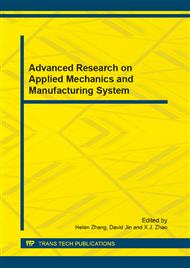[1]
Wang guangfu, Liao Rongfeng, Li Jianglong et al. The development situation and future of low permeability oil reservoirs of SINOPEC. PGRE[J]. Petroleum Geology and Recovery Efficiency 2007, 14(3): 84-89(In Chinese).
Google Scholar
[2]
Hao Mingqiang, Hu Yongle, Liu Xiangui. An overview on characteristics of low-permeability fractured reservoirs[J]. Special Oil and Gas Reservoirs, 2007, 14(3): 12-15(In Chinese).
Google Scholar
[3]
Michael W. Conway, Steven W. Lindeman, Robert D. Barree. Selection of stimulation fluids and treatment design for low-permeability reservoirs[R]. SPE 106085(2007).
DOI: 10.2118/106085-ms
Google Scholar
[4]
Li Jun Yu, Jilei Feng, Shuguang Zhang et al. Research on development rules and strategies in the low R/P ratio of tarim major sandstone reservoirs[R]. SPE 131333(2010)(In Chinese).
DOI: 10.2118/131333-ms
Google Scholar
[5]
D. IIK,S.M. Currie,D. Symmons et al. Hybrid rate-decline models for the analysis of production performance in unconventional reservoirs[R]. SPE 135616 (2010).
DOI: 10.2118/135616-ms
Google Scholar
[6]
Victoria U. Okotie, Robert L. Moore. Well-production challenges and solutions in a mature, very-low-pressure coalbed-methane reservoir. [R]. SPE 137317(2011).
DOI: 10.2118/137317-pa
Google Scholar
[7]
Li Yanxing, Han Lingchun, Dong Pingchuan, et al. Study on econimic limits for horizontal well in low-permeability reservoir[J]. Acta Petrolei Sinica, 2009, 30(2): 242-246(In Chinese).
Google Scholar
[8]
Ge Jiali, Ning Zhengfu, Liu Yuetian, et al. The principal of percolation mechanics in modern reservoirs[M]. Beijing: Petoleum Industry Press, 2001: 127-135(In Chinese).
Google Scholar
[9]
Yang Shenlai, Wei Junzhi. The physics of oil formation[M]. Beijing: Petoleum Industry Press, 2004:268-270(In Chinese).
Google Scholar
[10]
Qi Yin, Zhang Ningsheng, Ren Xiaojuan, et al. Experimental study on the flowing characteristics of single phase oil in super-low permeability reservoirs[J]. Journal of oil and gas tecnology, 2005, 27(2): 366-368(In Chinese).
Google Scholar
[11]
Li Daopin. Decision theory of low-permeability oilfield development[M]. Beijing: Petoleum Industry Press, 2003: 56-97(In Chinese).
Google Scholar
[12]
Chen Xinbin, Chang Yuwen, Wang Yanling, et al. Percolation mechanism and application of a production-decline model in low-permeability reservoirs[J]. Acta Petrolei Sinica, 2011, 30(2): 242-246(In Chinese).
Google Scholar


